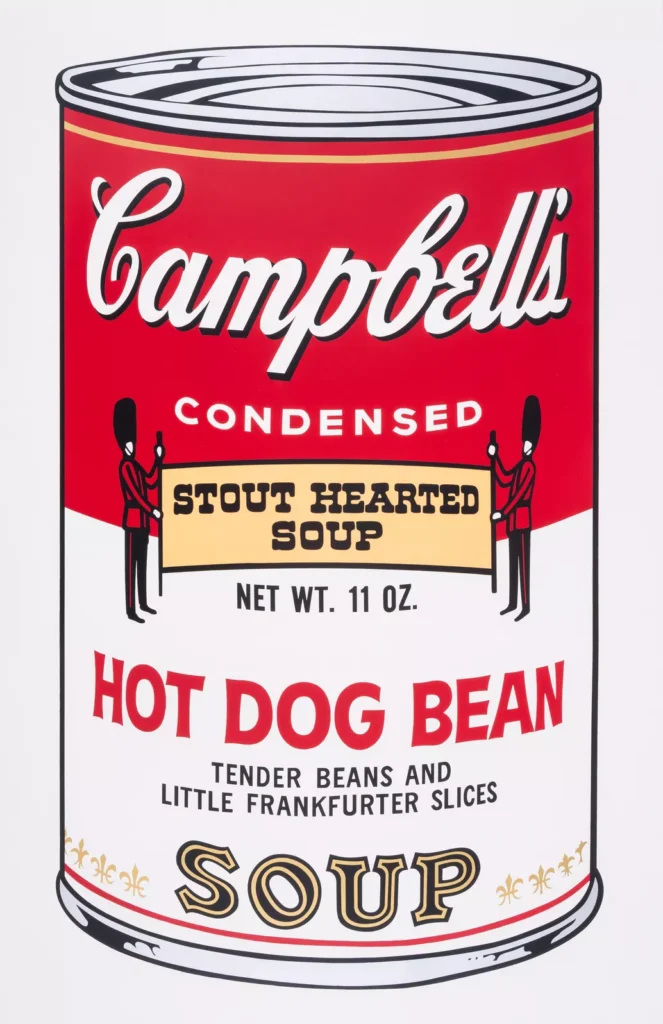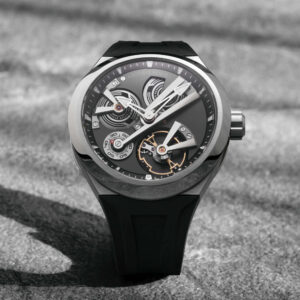Andy Warhol’s artistic practice has long been synonymous with the rise of Pop Art, an era of visual culture defined by a fierce intimacy with consumer goods, celebrity worship, and mass production. Among his most recognizable contributions to 20th-century art is the Campbell’s Soup series, originally debuted in 1962, and later revisited and expanded in 1969 with Campbell’s Soup II. It is within this later sequence that Hot Dog Bean finds its place: a curious entry in a sequence of canned soups, rendered not with painterly nuance but with the mechanical coolness of silkscreen, repetition, and the consumer’s gaze.
Warhol’s Hot Dog Bean may seem, at first glance, to be nothing more than a variant in a series of familiar labels. But this very familiarity is precisely where the image draws its strange power. What does it mean for a can of hot dog-flavored beans to be made immortal in the canon of Western art? What aesthetic lineage allows a processed meal to share a pedestal with oil portraits and marble busts? This article seeks to answer these questions, to historicize Hot Dog Beanwithin both the art world and the broader sociocultural moment of late 1960s America.
The Rise of Warhol and the Pop Art Movement
The 1960s were a transformative decade in American art, with Pop Art emerging in opposition to the high seriousness of Abstract Expressionism. While Jackson Pollock and Mark Rothko sought transcendence through expressive form and metaphysical emotion, Warhol sought engagement with the here and now—the supermarket aisle, the Hollywood tabloid, the television screen. Born in Pittsburgh in 1928, Warhol had been trained as a commercial illustrator before entering the fine arts. His early career with shoe advertisements and magazine layouts gave him a natural intuition for the languages of advertising and visual branding.
Warhol’s first Campbell’s Soup Cans series, created in 1962, featured 32 canvases representing each variety sold by the company at the time. The series shocked and fascinated critics and audiences alike. What was initially seen by many as a superficial joke—art mimicking grocery store goods—soon revealed itself as a deep interrogation of capitalism, repetition, identity, and even death. By turning a machine-made, consumable product into an object of contemplation, Warhol was suggesting that America’s collective soul might already reside within the barcode and the logo.
The success of the 1962 series eventually gave rise to Campbell’s Soup II in 1969. This time, rather than painting the images by hand or using stencils, Warhol leaned into screenprinting—a method used widely in commercial print shops, allowing for quick reproduction and a crisp flatness that emphasized his subject’s mechanical nature. The series included 10 new soup varieties, each screenprinted on paper with synthetic polymer colors. Among them was Hot Dog Bean, perhaps the most eccentric of all.
Unpacking Hot Dog Bean: Between Joke and Monument
At its core, Hot Dog Bean is a visual replica of a soup can, an image that borrows nothing from abstraction or illusionism. Yet it is precisely its fidelity to commercial aesthetics that makes it so unsettling. The label’s typeface, blocky red banner, and simple image of a bowl of bean soup are all perfectly legible, preserved as if in a natural history museum.
What distinguishes Hot Dog Bean from the more common Tomato or Chicken Noodle flavors is its comedic absurdity. It’s a hybrid food—neither quite soup nor fully meal—created for mass consumption, yet somewhat off-putting in name. Warhol likely relished this uncomfortable ambiguity. His art was never about beauty or elegance in a traditional sense. It was about exposure: of fame, of desire, of banality, and of taste in all its contradictory forms.
By selecting Hot Dog Bean as one of the ten additions to his Campbell’s Soup II portfolio, Warhol continued to blur the lines between the serious and the ridiculous, the artful and the artless. The humor is not lost on the viewer, but neither is the eeriness. It is a portrait of American consumer culture dressed up in its Sunday best—clean, consistent, mass-producible.
Screenprint as Mechanism, Metaphor, and Meaning
Warhol’s screenprinting technique played a crucial role in the meaning of the work. The method allows for near-perfect replication—each print looks more or less identical. And yet, small inconsistencies inevitably creep in: an ink smudge, a color that bleeds too far, a tiny misalignment. Warhol embraced these flaws, allowing the process to mirror the slight misalignments and imperfections of factory production itself.
In this way, the Hot Dog Bean print is both machine-made and uniquely human. The image is flat, but not dead; mass-produced, but not without its aura. This was one of Warhol’s greatest achievements—to restore a sense of presence to objects that had been numbed by overexposure. He did not paint from life; he painted from packaging, photography, media clippings. And in doing so, he created a new visual reality, one that mirrored the shifting perceptions of postwar America.
Consumerism and Cultural Critique
Hot Dog Bean can also be read as a cultural critique, albeit a subtle one. By elevating a canned food to high art, Warhol was making a point about what America consumed—not only with their mouths, but with their eyes and minds. The 1960s marked a boom in processed foods, fast food chains, and TV dinners. The industrialization of the American diet paralleled the homogenization of American culture. Regional tastes gave way to national brands. Homemade gave way to pre-packaged. Warhol’s soup cans, including Hot Dog Bean, serve as aesthetic tombstones to that shift.
Yet there is no explicit condemnation in Warhol’s approach. He doesn’t tell us whether Hot Dog Bean is good or bad, tasteful or tasteless. His detachment is part of his genius. By refusing to moralize, he invites the viewer to project their own interpretation. Is this work ironic? Is it a celebration of the everyday? Is it an act of artistic rebellion, or corporate complicity? The answer is, perhaps, all of the above.
Context of 1969: A Culture in Flux
When Warhol returned to the soup can motif in 1969, the United States was a very different place from the early 60s. The optimism of the Kennedy era had given way to the protests of Vietnam, the rise of counterculture, and the trauma of political assassinations. Yet consumerism marched on undeterred. In fact, some would argue that it accelerated, as corporations realized they could sell rebellion just as easily as conformity.
In this environment, Hot Dog Bean takes on a different tone. It becomes a kind of relic—a quiet insistence that the ideals of convenience, branding, and image-making were still alive and well, even as society unraveled. Warhol himself had been shot by Valerie Solanas just a year earlier, in 1968. The incident left him physically and emotionally altered. His work following the shooting often took on a more muted, distant quality. Hot Dog Bean, in its pristine stillness, reflects that shift.
Reception and Legacy
The Campbell’s Soup II series was not received with the same initial shock as the 1962 original. By 1969, the art world had come to understand, if not fully embrace, Warhol’s sensibility. Collectors now clamored for his work. Museums began acquiring his prints. Critics, while still divided, could no longer ignore his cultural relevance.
Hot Dog Bean has since become a beloved oddity within the Warhol canon. It is reproduced frequently in books, exhibitions, and retrospectives. It has also found a peculiar second life on merchandise—mugs, T-shirts, posters—ironically reinforcing the very commodification that Warhol was both mimicking and mocking.
In contemporary times, as discussions about food justice, corporate ethics, and consumer fatigue grow louder, Warhol’s soup cans feel as relevant as ever. Hot Dog Bean, once a novelty, now stands as a reminder of how far into the realm of image—and irony—our society has drifted.
Final Thoughts: The Aesthetic of the Ordinary
Andy Warhol’s Hot Dog Bean is a lesson in looking again. It teaches us to find meaning not in the sublime or the rare, but in the common and the mass-produced. It is a mirror held up to a world where brands are more recognizable than people, where food is sold through desire rather than nourishment, and where art is whatever we are willing to contemplate deeply.
In Hot Dog Bean, Warhol captures the contradictions of modern life: humor and horror, beauty and banality, originality and replication. It is a quiet work, but not a simple one. It invites reflection not through grandeur, but through its absolute, deliberate ordinariness.
And perhaps that is Warhol’s most enduring message—that in the age of media and marketing, the most radical thing an artist can do is take the familiar, and make it strange again.
No comments yet.








